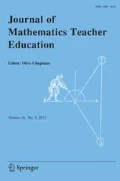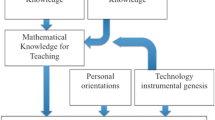Abstract
This study investigates three teachers’ uses of a dynamic geometry program (The Geometer’s Sketchpad) in their high school geometry classes over a 2-year period. The researchers examine teachers’ actions and questions during pivotal teaching moments to characterize mathematics instruction that utilizes technology. Findings support an association between teacher–tool relationships, predominant teacher actions, and questioning.




Similar content being viewed by others
References
Boaler, J., & Brodie, K. (2004). The importance, nature and impact of teacher questions. In D. E. McDougall & J. A. Ross (Eds.), Proceedings of the 26th annual meeting of the North American Chapter of the International Group for the Psychology of Mathematics Education (Vol. 2, pp. 773–781). Toronto: Ontario Institute of Studies in Education/University of Toronto.
Boaler, J., & Humphries, C. (2005). Connecting mathematical ideas: Middle school video cases to support teaching and learning (Vol. 1). Portsmouth, NH: Heinemann Educational Books.
Farrell, A. M. (1996). Roles and behaviors in technology-integrated precalculus classrooms. Journal of Mathematical Behavior, 15(1), 35–53.
Fraivillig, J. L., Murphy, L. A., & Fuson, K. C. (1999). Advancing children’s mathematical thinking in everyday mathematics classrooms. Journal for Research in Mathematics Education, 30(2), 148–170.
Franke, M. L., Webb, N. M., Chan, A. G., Ing, M., Freund, D., & Battey, D. (2009). Teacher questioning to elicit students’ mathematical thinking in elementary school classrooms. Journal of Teacher Education, 60(4), 380–392.
Goos, M., Galbraith, P., Renshaw, P., & Geiger, V. (2000). Reshaping teacher and student roles in technology-enriched classrooms. Mathematics Education Research Journal, 12(3), 303–320.
Hollebrands, K., Cayton, C., & Boehm, E. (2013). Pivotal teaching moments in a technology-intensive secondary geometry classroom. In A. M. Lindmeier & A. Heinze (Eds.). Proceedings of the 37th International Group for the Psychology of Mathematics Education (Vol 3, pp. 73–80). Kiel, Germany.
Hufferd-Ackles, K., Fuson, K. C., & Sherin, M. G. (2004). Describing levels and components of a math-talk learning community. Journal for Research in Mathematics Education, 35(2), 81–116.
Kendal, M., & Stacey, K. (2002). Teachers in transition: Moving towards CAS-supported classrooms. ZDM: The International Journal of Mathematics Education, 34(5), 196–203.
Laborde, C. (2002). Integration of technology in the design of geometry task with Cabri-Geometry. International Journal of Computers for Mathematical Learning, 6(3), 283–317.
Mason, J. (2000). Asking mathematical questions mathematically. International Journal of Mathematical Education in Science and Technology, 31(1), 97–111.
National Governors Association Center for Best Practices, Council of Chief State School Officers. (2010). Common core state standards for math. National Governors Association Center for Best Practices, Council of Chief State School Officers, Washington, D.C.
Sherin, M., Jacobs, V., & Philipp, R. (Eds.). (2011). Mathematics teacher noticing: Seeing through teachers’ eyes. London: Routledge.
Sinclair, M. (2003). Some implications of the results of a case study for the design of pre-constructed, dynamic geometry sketches and accompanying materials. Educational Studies in Mathematics, 52(3), 289–317.
Smith, M., & Stein, M. K. (2011). 5 Practices for orchestrating productive mathematics discussions. Reston, VA: National Council of Teachers of Mathematics.
Star, J. R., & Strickland, S. K. (2008). Learning to observe: Using video to improve preservice mathematics teachers’ ability to notice. Journal of Mathematics Teacher Education, 11(2), 107–125.
Stein, M. K., Grover, B. W., & Henningsen, M. (1996). Building student capacity for mathematical thinking and reasoning: An analysis of mathematical tasks used in reform classrooms. American Educational Research, 33(2), 455–488.
Steinbring, H. (1989). Routine and meaning in the mathematics classroom. For the Learning of Mathematics, 9(1), 24–33.
Stockero, S. L., & Van Zoest, L. R. (2013). Characterizing pivotal teaching moments in beginning mathematics teachers’ practice. Journal of Mathematics Teacher Education, 16(2), 125–147.
Straesser, R. (2002). Cabri-géomètre: Does dynamic geometry software (DGS) change geometry and its teaching and learning. International Journal of Computers for Mathematical Learning, 6(3), 319–333.
Tyminski, A. M. (2010). Teacher lust: Reconstructing the construct for mathematics instruction. Journal of Mathematics Teacher Education, 13(4), 295–311.
Van Es, E. A., & Sherin, M. G. (2008). Mathematics teachers’ “learning to notice” in the context of a video club. Teaching and Teacher Education, 24(2), 244–276.
Wilson, P. H., Lee, H., & Hollebrands, K. (2011). Understanding prospective mathematics teachers’ processes for making sense of students’ work with technology. Journal for Research in Mathematics Education, 42(1), 39–64.
Wood, T. (1998). Alternative patterns of communication in mathematics classes: Funneling or focusing? In H. Steinbring, M. Bartolini-Bussi, & A. Sierpinska (Eds.), Language and communication in the mathematics classroom (pp. 167–178). Reston, VA: National Council of Teachers of Mathematics.
Zaslavsky, O. (2005). Seizing the opportunity to create uncertainty in learning mathematics. Education Studies in Mathematics, 60(3), 297–321.
Zbiek, R. M., Heid, M. K., Blume, G. W., & Dick, T. P. (2007). Research on technology in mathematics education: A perspective of constructs. In F. K. Lester (Ed.), Second handbook of research on mathematics teaching and learning (Vol. 2, pp. 1169–1207). Charlotte, NC: Information Age.
Zbiek, R., & Hollebrands, K. (2008). A research-informed view of the process of incorporating mathematics technology into classroom practice by inservice and prospective teachers. In M. K. Heid & G. Blume (Eds.), Handbook of research on technology in the learning and teaching of mathematics: Syntheses and perspectives (pp. 287–344). Greenwich, CT: Information Age (invited chapter).
Author information
Authors and Affiliations
Corresponding author
Rights and permissions
About this article
Cite this article
Cayton, C., Hollebrands, K., Okumuş, S. et al. Pivotal teaching moments in technology-intensive secondary geometry classrooms. J Math Teacher Educ 20, 75–100 (2017). https://doi.org/10.1007/s10857-015-9314-y
Published:
Issue Date:
DOI: https://doi.org/10.1007/s10857-015-9314-y




